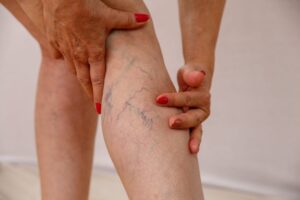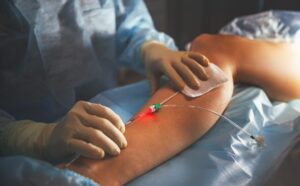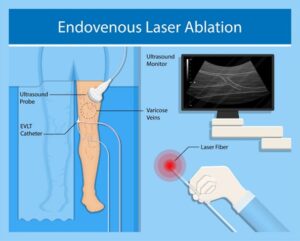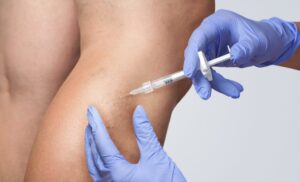Vein Clinic
The Difference is 
Clear Medical Imaging is already your choice for patient-centered industry-leading compassionate care. We are now pleased to offer a full range of venous assessment and treatments beyond diagnostic ultrasound, including endo-vascular specialist consultation and the latest in advanced superficial vein treatments.
Diagnostic Imaging, Specialist Consultation & Advanced Vein Treatment
The Clear Vein Centre’s goal is to provide an accurate diagnosis and advise appropriate treatments for anyone with venous disease.
Venous Disease FAQ
What is venous insufficiency?
Venous insufficiency is a common condition when blood return (from the legs to the heart) is inadequate, which results in pooling of blood in veins. Blood return to the heart is usually aided by one-way valves which help blood move against gravity, but when these valves become weak or insufficient, they allow blood to flow backwards which is called reflux.
What are varicose veins?
Varicose veins are veins that have become dilated and elongated which often result in their tortuosity. These swollen vessels are a result of insufficiency or reflux described above. A common cause of varicose veins is reflux in the largest superficial thigh vein known as the greater saphenous, which can cause visible and especially symptomatic varicose veins anywhere from the thigh to the calf.
How varicose veins form:
What are the symptoms of varicose veins or venous insufficiency?
Symptoms overall tend to worsen as the day progresses or with prolonged standing. These include leg fatigue (tired legs), dull ache, leg heaviness, burning sensation, itch, swelling and throbbing. Some patients find they need to sit down and elevate their legs to relieve these symptoms. When severe and untreated, venous insufficiency and reflux can lead to darkening/discoloration of skin, swelling/edema, and wounds or ulcers that can be very difficult to treat. Not uncommonly, patients can also have symptoms without any visible varicose veins – this is why a complete venous assessment is ideal.
Is treatment necessary?
Every patient with spider veins, varicose veins, or other forms of venous insufficiency should following a healthy lifestyle to help relieve symptoms and prevent further damage to both their veins and the surrounding skin (see conservative treatments section). While many will notice a benefit with weight control, regular exercise and graduated support stockings, some patients will choose added treatments to help improve appearance or relieve symptoms that may persist despite these conservative measures.
What are the risk factors associated with varicose veins?
- Gender: Women get varicose veins more often than men.
- Weight: Being overweight puts greater pressure on your veins, which can cause them to stretch/dilate and make it harder for the blood to return to the heart.
- Age: Like all the body’s tissues, valves and vein walls often get weaker and lose elasticity (collagen) with age.
- Genes: Genetics play a significant role in venous disease. Varicose veins can run in families.
- Activity: Patients who sit or stand in one place all day can have more pooling of blood in their legs.
- Pregnancy: An increase in blood volume during pregnancy along with added pressure of the baby on veins in the pelvis can lead to swelling and sometimes varicose veins. These often go away after giving birth, but sometimes do not.
Which treatment is best?
No single treatment is superior to the others. The optimal treatment will depend on the size, location, and types of damaged veins. This is why a dedicated venous assessment is performed which will allow a tailored treatment plan for each patient. Often a combination of treatments is required to successfully treat varicose veins. Venous disease is a chronic disease that often requires ongoing maintenance or extrinsic support.
Will these problem veins return?
Being a chronic disease, venous insufficiency does require ongoing maintenance (at least in the form of the conservative measures). Unfortunately, the underlying genetics of the vein walls and valves will always remain, and therefore troublesome veins can reappear months or years after any form of treatment. The vast majority of patients will see a significant improvement following treatment, and most of these will be durable results, but periodic re-assessment and minor treatments (typically conventional sclerotherapy) are often necessary. A small number of patients may require further major treatments which would be included/guaranteed for 5 years following an EVLT (98% success rate).
Who will perform my ablation/EVLT?
If you are a candidate for the minimally-invasive treatment known as ablation or laser treatment of your insufficient veins, this procedure is performed by an interventional radiologist (IR). This is a specialized physician who sub-specializes in minimally-invasive procedures using imaging guidance in all areas of the body, especially within or through blood vessels. These treatments range from peripheral arterial disease (angioplasty & stenting), peripheral venous disease, directed cancer treatments, venous access (for cancer treatments, IV antibiotics, or hemodialysis), uterine fibroid embolization, acute stroke treatment (endovascular thrombectomy), feeding tube placement, kidney/bladder/biliary/abscess drains, trauma embolization (stop bleeding from the inside), pain injections, compression fracture treatments (vertebroplasty), and image-guided biopsies.
What is Interventional Radiology?
- https://cairweb.ca/en/cair-initiative/what-is-interventional-radiology/
- https://oarinfo.ca/patient-info/radiology-medical-services/interventional-radiology
- https://www.theii.org/miips/procedures
Treatments
Conservative Treatment
Venous insufficiency is very common and occurs when blood return from the legs to the heart is hindered. Normal one-way valves in these veins typically keep blood flowing against gravity, but when these become weak or fail, they allow reversed blood flow (called reflux) and pooling of blood in the legs. See the FAQ section for further details.
Lifestyle measures are the first line of defense and include regular exercise, maintaining a healthy weight, periodic leg elevation, and wearing graduated compression stockings.
Medical grade graduated compression stockings provide most compression around the foot and ankle and gradually reduce pressure as they move up the leg. They reduce pooling of blood in the superficial veins of the legs. We offer specific sizing tailored for your legs with easy to maintain (washer & drier safe) synthetic quality stockings by Medi.
These are an investment in your health and wellbeing and typically range from $104 to $164 per pair depending on size, type and colour. Prescription compression stockings are often a covered insurance benefit so be sure to look into your benefits coverage before your appointment to see.
While the above can improve symptoms and reduce disease progression, they cannot reverse existing damage. Only further treatments can remove spider or varicose veins.
EVLT – Endo-Venous Laser Therapy
We may suggest EVLT if you have varicose veins that are a result of venous insufficiency or reflux within the major superficial (saphenous) veins of the leg. This is performed at the Clear Medical Imaging Ouellette location using the newest generation of laser to permanently collapse and seal the damaged veins using only local anesthetic. The minimally-invasive procedure takes under an hour and is performed under ultrasound-guidance typically through a single 2 millimeter (1/16th inch) access site leaving virtually no scars and with a treatment success of over 98%! Patients can resume normal activities within a day and typically return to work within 24-48 hours.
Following EVLT you will wear compression stockings fitted for the correct size and type needed – which we perform on site – for a period of two weeks. Accurately fitted compression stockings are essential to ensure success of the procedure. You can expect to recover quickly with only minor discomfort that can be relieved by over-the-counter anti-inflammatories (Ibuprofen) and Tylenol. This discomfort is MUCH less than comparable surgery, but you may experience a pulling or aching sensation in the treatment area for a few days – this is normal. Bruising is common but usually clears within 1-2 weeks.
Once EVLT has treated the main refluxing superficial veins, most of the varicose and smaller tributaries will shrink and many will disappear after 6-8 weeks – you will not notice an immediate improvement. Following this, any remaining troublesome veins may be treated with sclerotherapy (see below). This sclerotherapy treatment of any remaining varicose veins is included with the EVLT.
The alternative to EVLT is surgical stripping and ligation which is the traditional method. This involves a general anesthetic in the operating room at the hospital with an incision in the groin and lower leg through which a long instrument is inserted the length of the leg/vein to strip it inside out and tear off side-branches. This involves 2-6 weeks of recovery time with significant bruising, hematoma, and pain. Surgical stripping has a recurrence/failure rate of up to 25% and a double digit risk of nerve damage even in the best of hands.
Sclerotherapy
Conventional injection sclerotherapy can may be suggested if you require treatment of small superficial veins. This may be your only treatment, or it may follow removal or ablation of larger varicose veins by Laser Therapy (EVLT). Sclerotherapy is performed at Clear Medical without the need for any anesthetic. The sclerosing agent is injected directly into veins with a very small needle. This works by causing inflammation and scarring the inner walls of the vein after which a compression bandage and stockings are applied to the skin to help the vein walls stick together and prevent blood from flowing into the damaged vein segment. This vein will go on to scar and be resorbed/disappear. In Greek, “sclero” means hard, which is what happens to a treated vein before it is resorbed: it hardens. Medical compression stockings are typically a required investment (see above conservative treatment section) following sclerotherapy to ensure optimal treatment results. You will NOT notice an immediate improvement. Healing usually occurs over a 3-8 week period and in some cases may take beyond 10 weeks. Often enough there is only a partial response after the first couple treatments with the veins looking a darker red or worse than before the treatments were started. This is part of the normal healing response. It may take three to five treatments for a specific area to demonstrate an adequate response or improvement in appearance.
Vein Clinic Locations
Windsor – Ouellette
- 1568 Ouellette Ave., Windsor N8X 1K7
- For further information please call:
- 519-256-4914 Ext 238







